Villagers Board Game Review
In the ever-expanding landscape of board games, it’s rare for a small-box title to pack the kind of punch that Villagers does. Designed by Haakon Gaarder and published by Sinister Fish Games, Villagers stands out as a lean, streamlined engine-builder that turns card drafting into a surprisingly strategic and deeply satisfying affair.
Set in a post-plague medieval world, you take on the role of a founder trying to rebuild a thriving village. Each card represents a potential villager with specific skills and connections—your job is to draft wisely, build production chains, and turn your humble hamlet into a prosperous community.
Simple at a glance, Villagers unfolds into a rich web of decisions involving chaining, unlocking professions, and maximizing value across timed markets. It’s quick to teach, fast to play, and incredibly fun to explore across many sessions.
📦 Player Count: 1–5 players
⏱️ Playtime: 30–60 minutes
🎯 Complexity: Light–Medium
🎲 Core Mechanics: Card drafting, engine building, tableau construction
🏡 Theme: Village rebuilding, medieval economy
Stay with us as we sit down with Villagers, the game itself, and discover how it turns simple card mechanics into a gold-generating village of delights.
What Makes Villagers’ Tableau Building So Appealing?
Me: Welcome, Villagers! Thank you for joining us on the show. You’ve got the look of a quiet, humble game—but people keep saying you pack more under the hood. Care to introduce your core mechanic?
Villagers: Aye, thanks kindly for havin’ me! I may not have the flash of city-folk board games, but what I do have is good honest craftin’ and clever chaining, just like we’ve done for generations in our valley. I’m a tableau builder through and through—draft cards in one phase, then build your little engine in the next.
Me: And what does that engine look like, exactly?
Villagers: Oh, it’s simple at first glance. Each card you play is a villager with a trade or skill—like the Lumberjack or the Carpenter. Some give you gold, others unlock new professions, and many rely on one another to function properly. It’s like settin’ up a production chain where each new worker adds a bit more life to your village.
Me: So it’s the combo potential that brings everything together?
Villagers: Exactly! The cards feed off each other like bread and stew—basic, but heartwarming. You’ll place a Foundry that unlocks the Blacksmith, who makes your Coinsmith more valuable. And suddenly, your sleepy town starts janglin’ with gold. It’s familiar ground for fans of tableau games, but I keep it clean, quick, and just tricky enough to make every decision matter.
Me: Sounds like a village worth visiting.
Villagers: That it is, friend. And we’ve only just started the tour. Let’s wander deeper and see what gives our quiet community such lively charm.
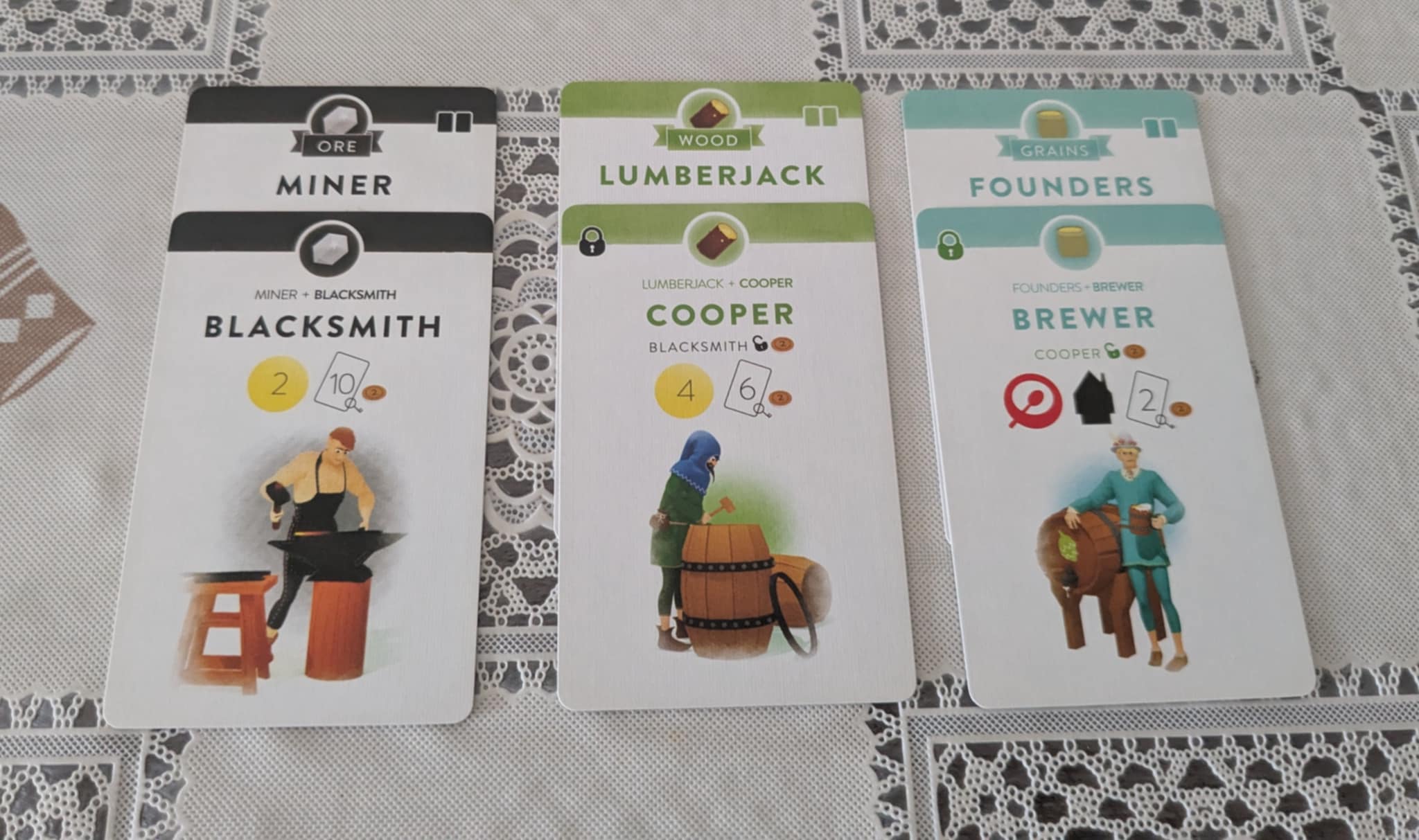
Why Are Some Villager Cards Worth More Than Others?
Me: Let’s talk more about the villager cards themselves. What makes some of them so valuable compared to others?
Villagers: Ah, well, that depends on where and when you use ’em, doesn’t it? You see, all us folk come from the same road—drafted from the central pool. But once we reach yer table, our value starts to change like the weather on a spring morning.
Me: How so?
Villagers: Some of us bring a pouch o’ gold right away, plain and simple. Others, though, are a bit more particular. Take a Silver producer, for example—might not look like much, but if yer village is dotted with the right symbols, that one card could be bringin’ in more coin than three others combined.
Me: So card synergy really matters?
Villagers: That’s the key! Take the Jeweler, for instance—a fine, shiny profession if there ever was one. But to invite them to your village, you’ll need to set the table just right with both a Seeker and a Spelunker. That’s quite the bit of groundwork before they start hammerin’ out gold.
Me: Sounds like a big investment.
Villagers: It is! But now, consider the humble Ore Muler. Doesn’t need fancy prerequisites—just loves a village with plenty o’ Ore symbols. You get the right set of cards on your tableau, and this little fella can spin you a fortune. One simple play, massive payout, no heavy lifting.
Me: So depending on your village setup, one card could be more valuable than a so-called powerful one?
Villagers: Aye. That’s what makes things spicy! You’re always lookin’ at what you’ve built and askin’, “Who fits in next?” Sometimes it’s not the flashiest lad, but the one who speaks your village’s language. Timing and synergy, that’s the song we dance to out here.
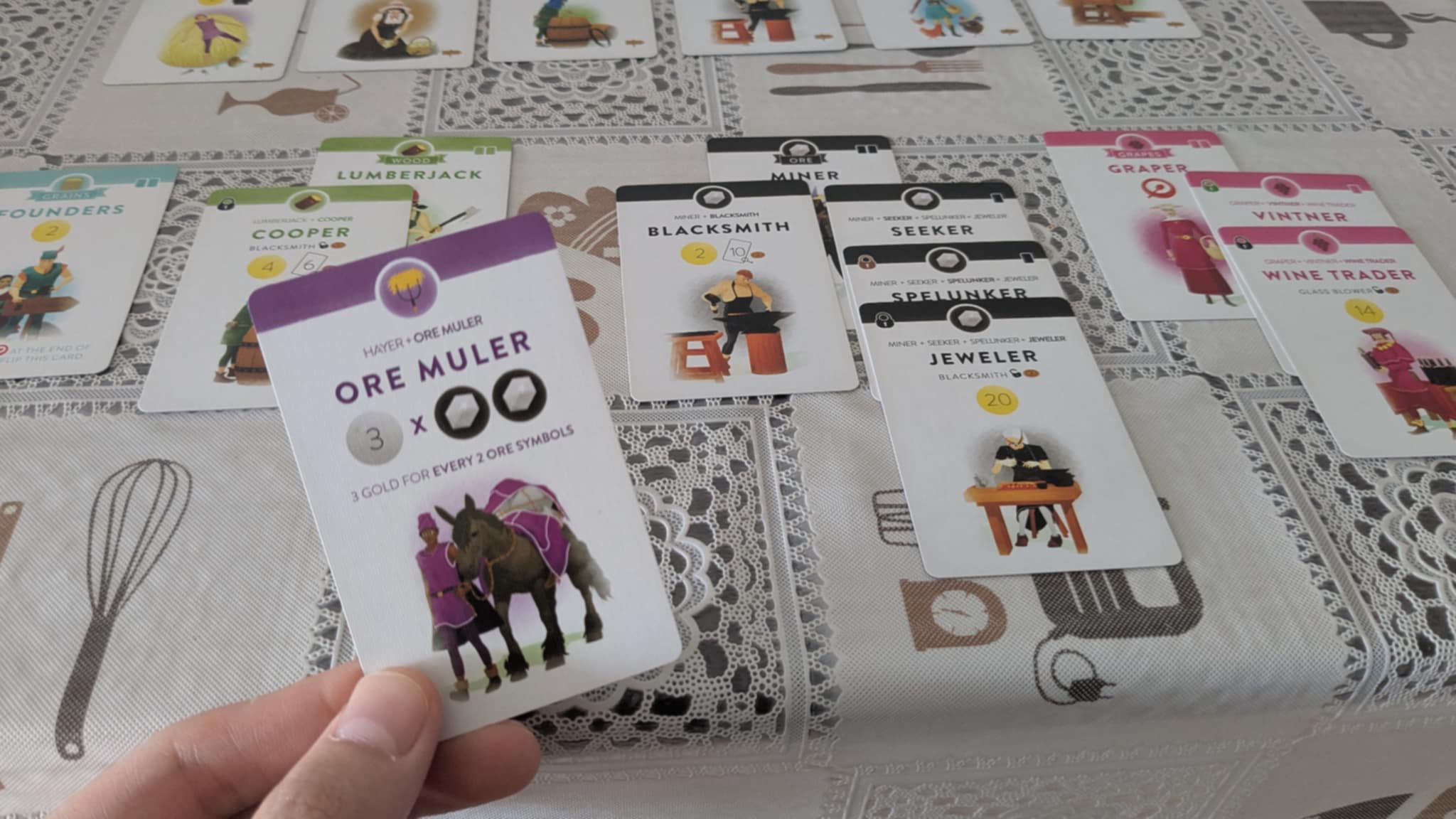
Strategic vs. Tactical Gold: The Two Paths of Villagers
Me: Earlier you mentioned villagers who bring in silver based on other cards, while others just deliver gold outright. What’s the difference between those two types of value?
Villagers: Ah, now we’re speakin’ the true language of our village economy! See, some of us just come in, get the job done, and drop a sack of gold on the table. Straightforward folk—like the Fromager or the Taylor—bless ’em. You draft ‘em, play ‘em, and you know exactly how much they’ll give you come Market Day.
Me: So, they’re more tactical choices?
Villagers: Exactly. Now, others—like the Log Rafter or the Ore Muler—well, they’re dreamers. Their worth depends on how much wood or ore your village can muster. They shine only if you’ve built around ‘em. That’s where your long-term vision, your strategy, comes in.
Me: But how do these two types of villagers affect your decision-making?
Villagers: That’s the magic, isn’t it? Sometimes, your hand’s full of Ore folk. So naturally, your eye’s on the Ore Muller—but if someone else snaps him up, you’ll be left wonderin’ if all that mining was worth it. Other times, a lone Grocer in your opening hand whispers promises of wealth, and you start chasin’ Food icons like a hungry fox.
Me: So you’re constantly adapting between short-term gains and long-term goals?
Villagers: Spot on. The game’s always askin’ you to weigh what’s good now versus what could be great later. That’s why no two villages ever look the same.
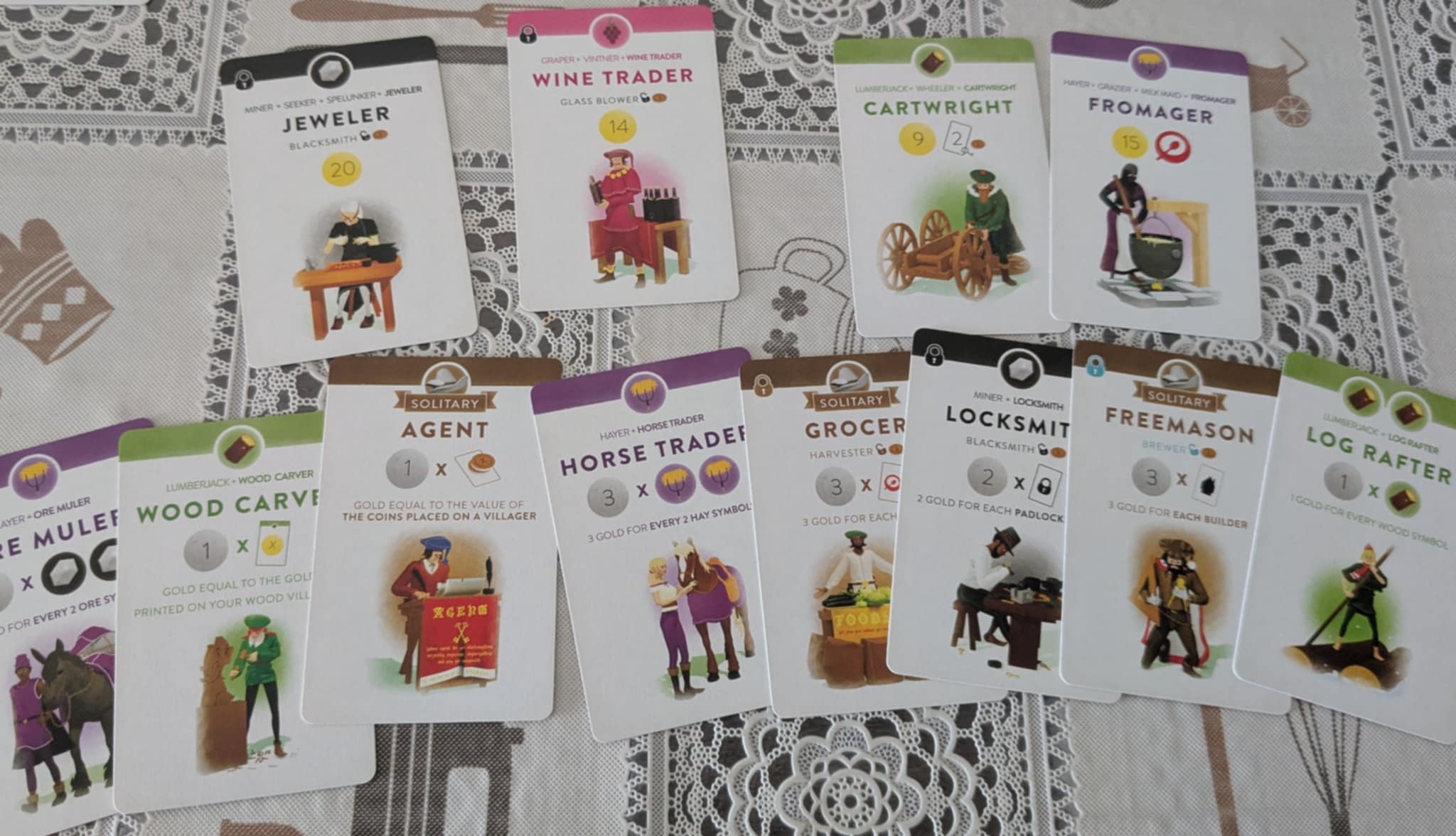
The Right Touch of Player Interaction in a Village of Solitude
Me: Now, most tableau-building board games are often criticized for being solitary affairs. What about you, Villagers? Do you interact much with the other players?
Villagers: Oh-ho! I may seem like a quiet little farming village, but don’t be fooled—we’ve got our fair share of elbow-rubbing and side-eye glances.
Me: How so?
Villagers: Well, for starters, everyone’s drafting from the same card pool. That means every pick you make is one someone else can’t. It’s a low-key tug-of-war—especially when you spot your neighbor stacking Hay icons and that juicy Horse Trader is just sitting there.
Me: So, is hate-drafting a valid tactic?
Villagers: Absolutely! And the best part is, hate-drafted cards aren’t dead weight. Say you take a card to block another player—well, turns out you can always spend it to recruit a basic villager like a Miner or Lumberjack. That’s resourcefulness for ya!
Me: But doesn’t that lead to more complexity?
Villagers: Not really! Even spent cards add spice to the game. When you place a basic villager using discarded cards, you tuck those cards face-down into the display. Suddenly, no one knows exactly what you’re holding or saving. It’s not bluffing like a card game, but it does keep folks guessing.
Me: So it’s just the right amount of tension and competition?
Villagers: Aye. I don’t go pickin’ fights, but I do keep my eyes on what the neighbors are buildin’. A village may be small, but its politics run deep.
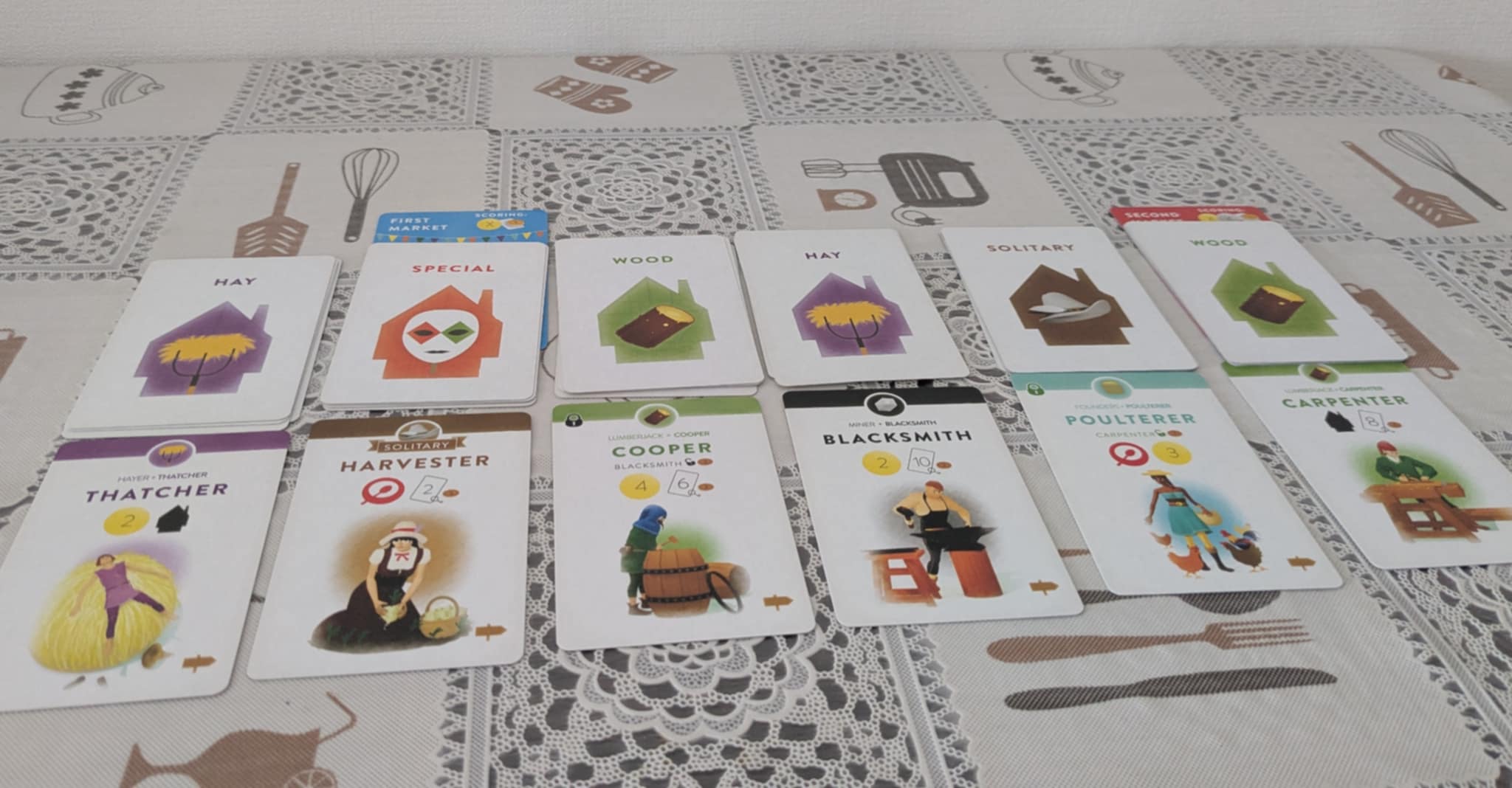
Unlocking Bonds: How Villagers Brings Theme and Progression to Life
Me: Earlier, you mentioned competition during the draft. But are there any other ways players interact?
Villagers: Aye, there’s another one—small and subtle, but oh, it warms my wool socks. Some of my folk need a bit of help to get started. Take the Jeweler, for example—they can’t do their job without someone else first finding a cave or two!
Me: So, they depend on other players?
Villagers: Exactly! Some cards require another card to unlock, and if you happen to have that unlocking card already in your village, every time another player builds one that relies on it, you get a shiny coin for the service. I call it the ol’ “bottle fee.”
Me: A bottle fee?
Villagers: Of course! Let’s say someone wants to produce wine. Well, they’ll need bottles, and only my trusty Glassblower can provide those. So they pay a coin, we clink mugs, and trade flows like the river.
Me: That’s unexpectedly charming. How does that tie into the game’s theme and sense of progression?
Villagers: That’s the real magic. My cards don’t just combo—they grow. You start with a Seeker who finds the Cave, then a Spelunker explores it, and finally, the Jeweler turns those discoveries into glittering gold. It’s more than points—it’s a story of development, trade, and community.
Me: So the village really comes alive over time?
Villagers: Oh yes. You’ll look down at your tableau and feel like you’ve built something real. From humble starts to bustling trades—now that’s a proper village tale.
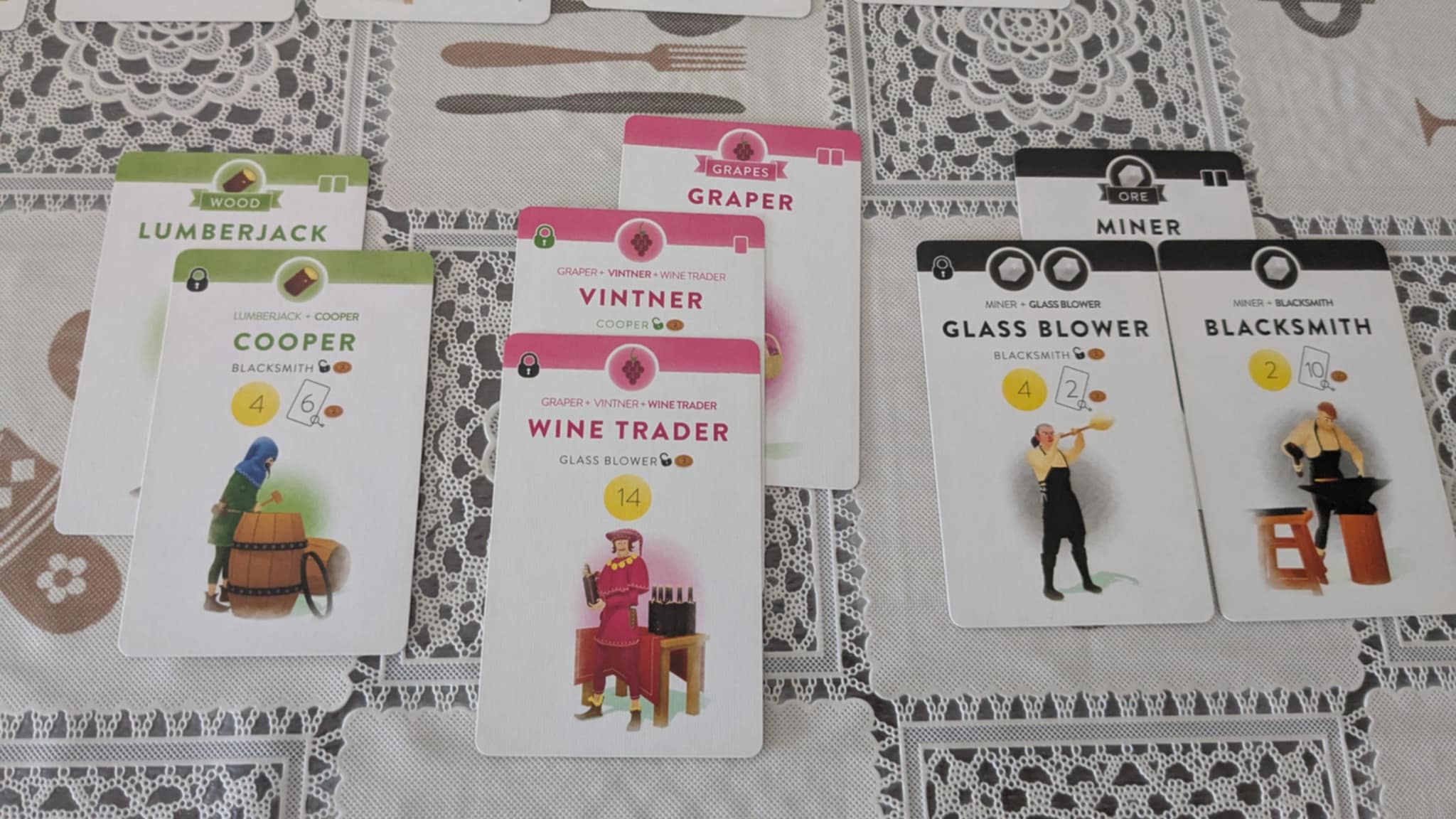
Are There Cracks in the Village Fence?
Me: Villagers, I’ve got to say, this all sounds incredibly polished. But surely life in the village isn’t always so idyllic. Any rough patches players should watch for?
Villagers: Oh, aye. Even the prettiest village has its muddy roads. For starters, I may look like a wee small-box game, but when you lay me all out, I sprawl like a harvest festival. You’ll need a grand table—or perhaps a neighboring barn.
Me: That sounds unexpected for something so compact.
Villagers: It surprises many. The set-up and tear-down are also more fiddly than you’d guess for a game that feels this breezy. There are a fair number of card stacks to sort, villagers to display, and tokens to set just right. Not overwhelming, but not exactly snappy either.
Me: What about gameplay? Any recurring hiccups there?
Villagers: I do pride myself on variety, but I’ll admit to a touch of predictability at the start. See, those opening villagers? The same six cards show up every game, and they’re just so good. It can lead to a rather samey first couple rounds—especially at certain player counts, where everyone scrambles for the same early engines.
Me: Sounds like something house rules could maybe tweak?
Villagers: Indeed, a clever host might rotate in variants or draft differently. Still, it’s a hiccup worth noting before setting up your stall at the market.
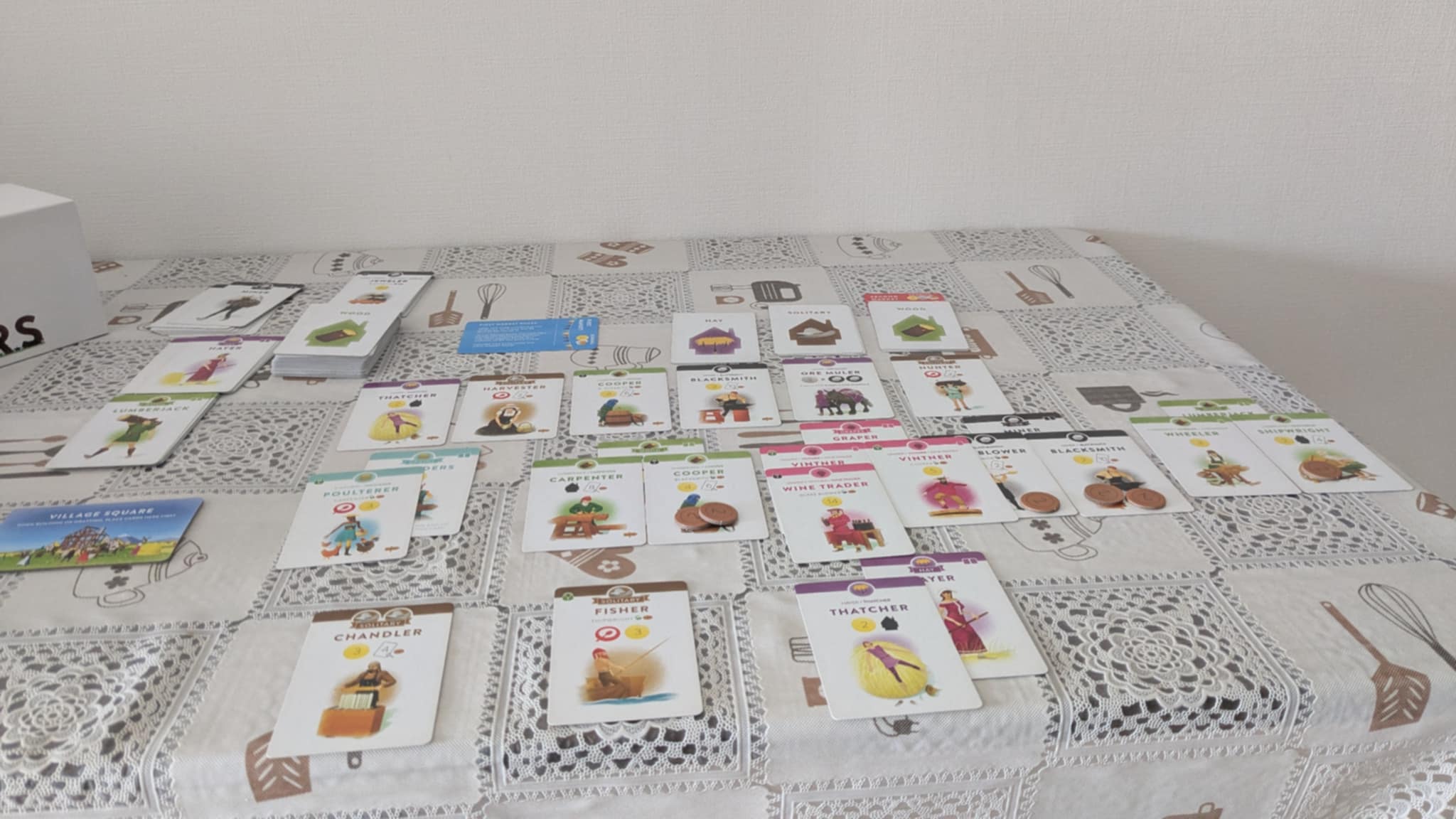
Final Verdict: A Lively Village Worth Visiting
Me: Villagers, you’ve given us quite the tour today—clever systems, charming touches, and a real sense of community. Any final thoughts before we wrap things up?
Villagers: Aye, thank you kindly for having me. I won’t pretend to be perfect—my tables are wide, my setup takes a bit, and I’ve a few repetitive habits at the start. But I bring joy, every single time. That’s the truth of it.
Me: And that joy comes from more than just clever mechanics. It’s how you understand tableau builders so well—how you twist the format just enough to keep it exciting.
Villagers: That’s me craft. I may be a modest design, but I pack a hearty punch. The satisfaction of combos, the shifting value of cards based on timing, the little nods to interaction and theme—it all knits together like a cozy quilt.
Me: You’ve made your mark in a genre overflowing with options. Not by being loud, but by being smart and warm.
Villagers: Bless you for sayin’ so. I’ll be here in the countryside, waiting to be brought out on game night. Whether it’s your first time visitin’ or your fiftieth, there’s always room at the table.
Me: Thank you for joining us today, Villagers. It’s been a pleasure.
Villagers: The pleasure was all mine. Safe travels, friend. And may your markets always be fruitful.
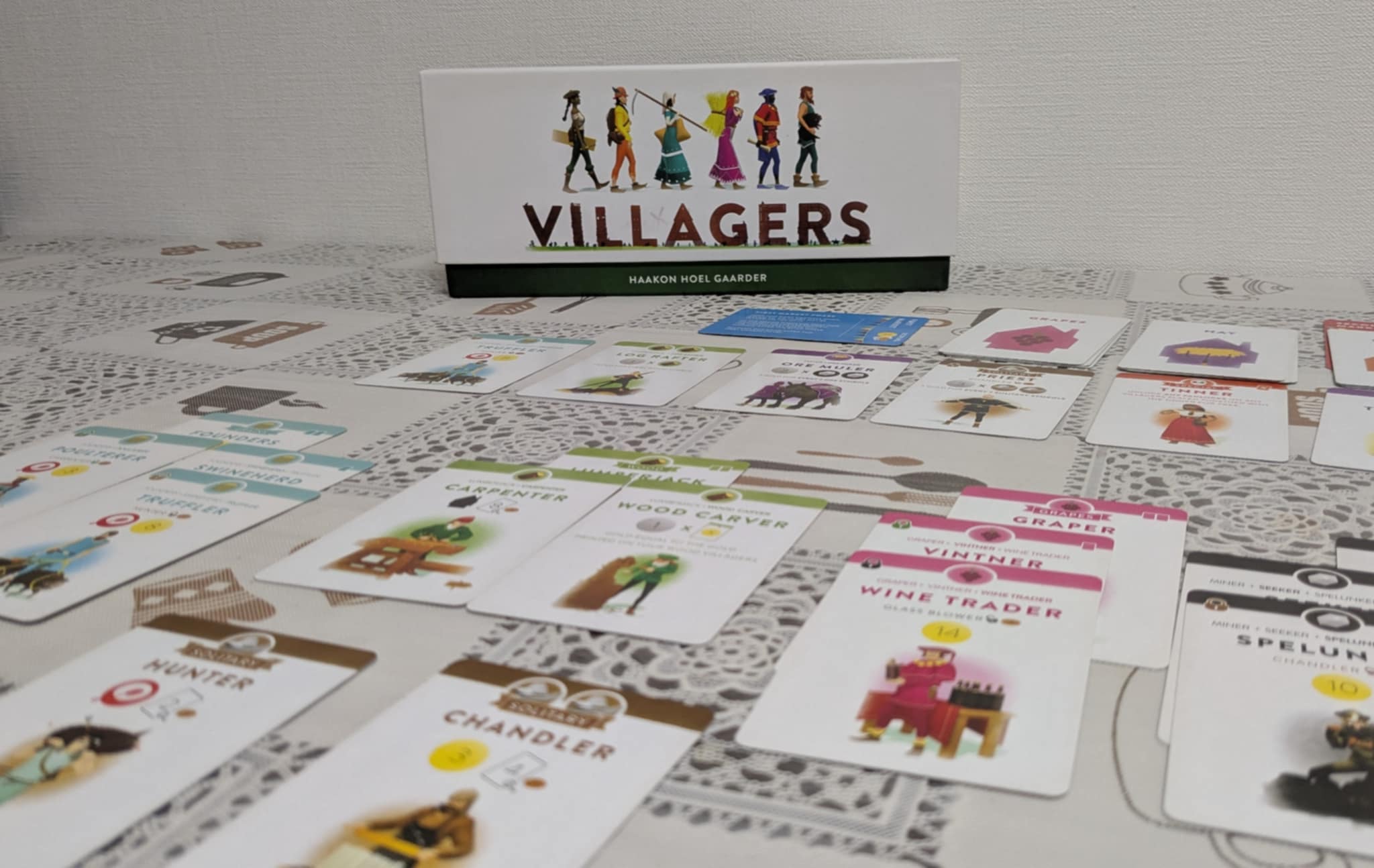
Conclusion
Villagers may come in a small box, but don’t let that fool you—it’s a full, satisfying experience. With simple mechanisms that cleverly echo the best parts of tableau building, this game offers a tight balance of combo-making, card value timing, and just enough player interaction to keep you watching the table. It’s a great reminder that accessibility doesn’t have to mean shallowness.
Alternative Recommendations:
If you’re looking for more in this space, Oh My Goods! offers compact, chain-production fun in a similarly small box. Splendor Duel big strategic decisions through smart drafting and resource planning for specifically at 2 players. And if you want a more thematic and contemplative eurogame experience with tableau elements, Uwe Rosenberg’s Agricola is an absolute treasure of this hobby.
Final Rating: 9/10
Pros:
- Simple design that captures the core of tableau builders
- Great player interaction
- Excellent sense of progression
- Strong thematic touches
Cons:
- Set up and tear down are a bit much
- A massive table hog
- Prone to set openings at specific player counts
Villagers may not reinvent the genre, but it absolutely earns its place on your shelf. A quaint, clever game that always leaves players smiling.




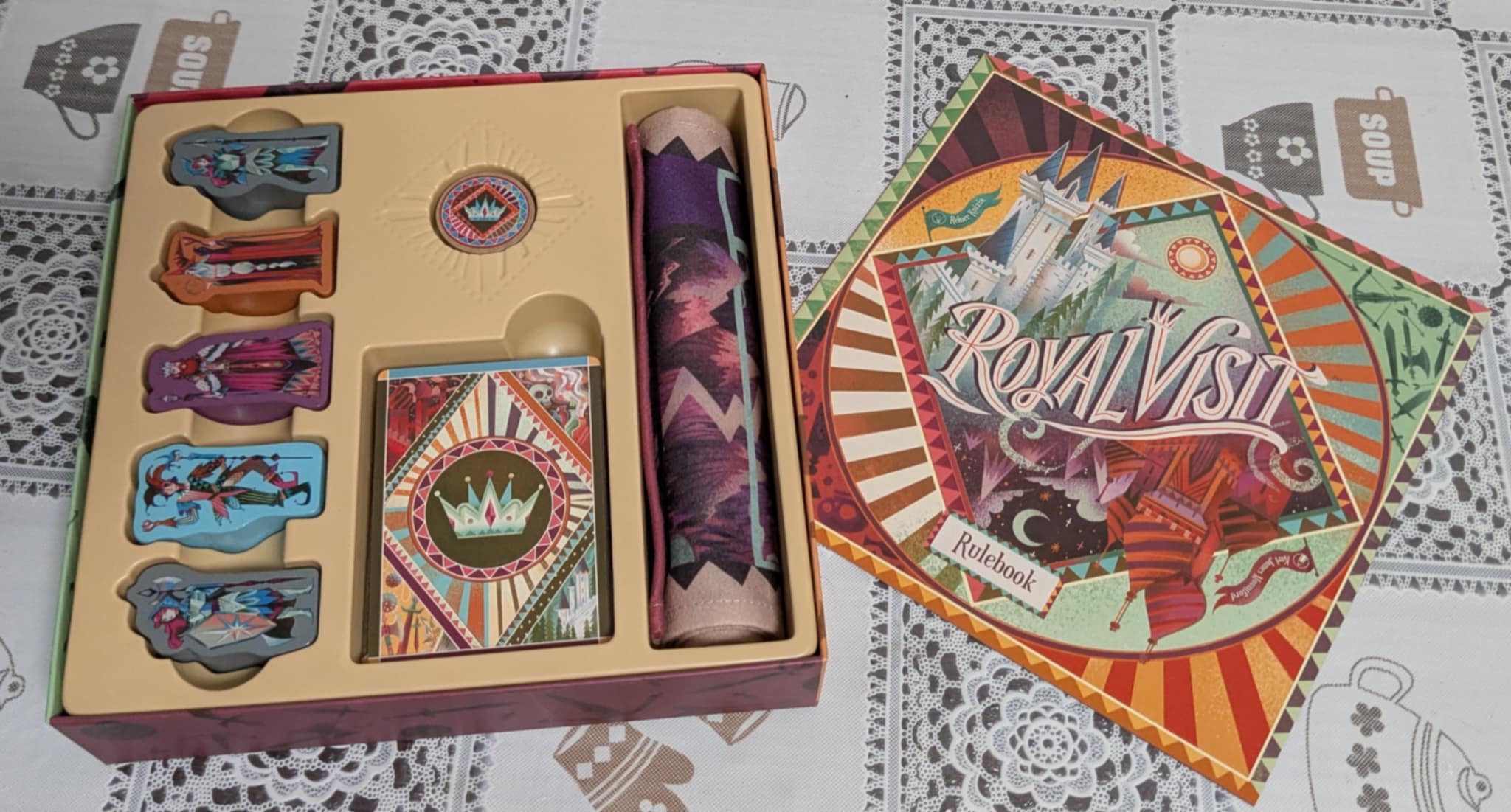
Leave a Reply